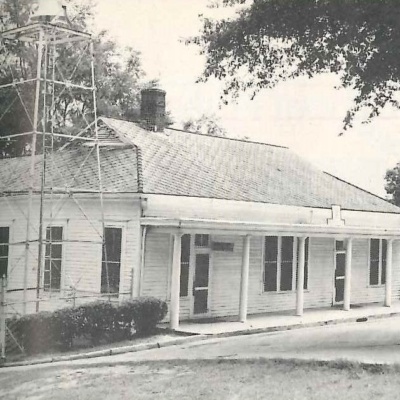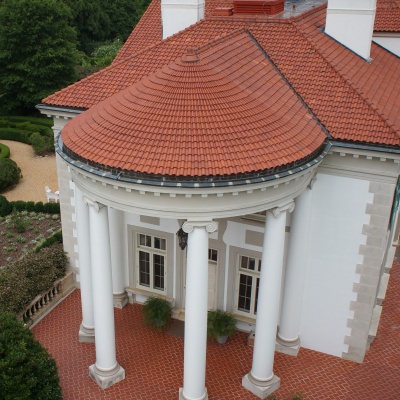Old World Charm
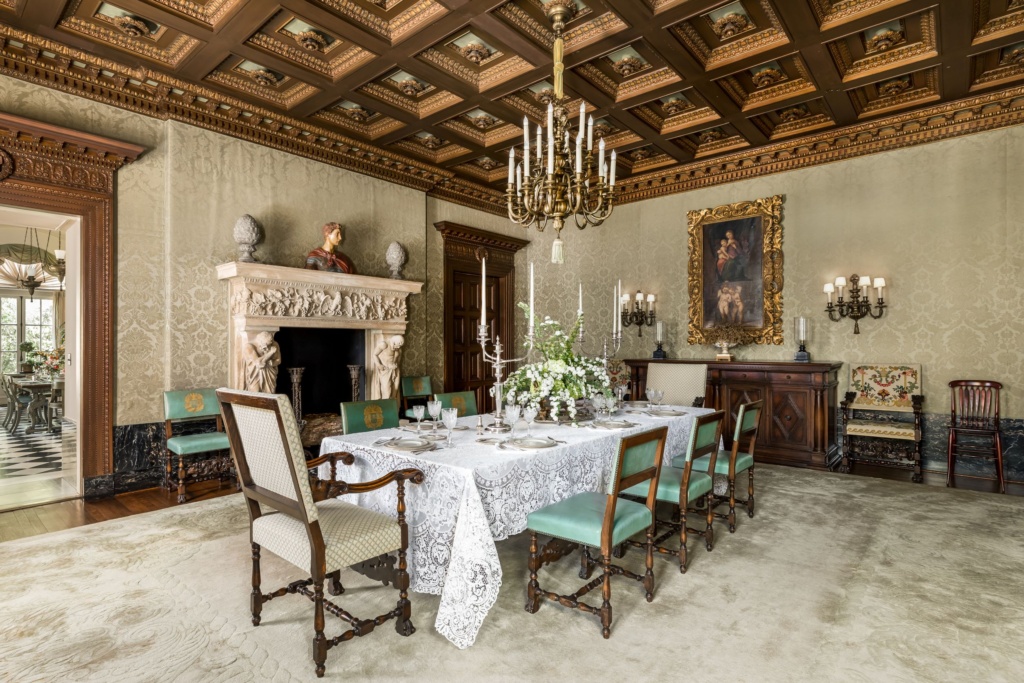
Back in 1914, when it was announced that Mr. Fuller E. Callaway was building a new home in LaGrange, the construction world was abuzz with excitement. Letters from building supply houses, contractors and all kinds of tradesmen began pouring into his office. Everyone wanted to sell their products and services and be part of the project! While correspondence with local vendors like Trimble Brick Company in Hogansville would be expected, this venture attracted interest from far afield, making me curious about the people who supplied the materials to create the Hills & Dales we love today.
A brief look through some of the letters and invoices revealed interesting names like Kriegshaber, Eichholz, Borgfeldt and Beaullieu among others. Who were these people and what did they do? As I leafed through the old faded papers, I remembered that the architects, Hal Hentz and Neel Reid, were inspired by European precedence, and wanted to capture a sense of Old World charm. Then it hit me—the story of Hills & Dales, a home for the quintessential Southern family, is in large part a story of immigrants. In 1958, John F. Kennedy wrote A Nation of Immigrants and famously said, “Everywhere immigrants have enriched and strengthened the fabric of American lives.” So, I decided to go beyond the company name on the letterhead and explore a few of the people who helped create this special place. I wanted to see if there were some interesting, undiscovered stories out there. To find out who the makers were, where they came from and determine how “far reaching” this place might be would be my challenge.
Well, sure enough, thanks to digital census and immigration records I did just that, and I made some connections across the sea that document the important role these individuals played in making the Callaway home at Hills & Dales Estate.
There are numerous pieces of antique English furniture in the Callaway home that regularly attract attention and are treasured family heirlooms. There is also a lovely English landscape painting prominently hanging over the fireplace in the Living Room. At least for a moment, it makes you feel like you have been transported to some English country estate. But the ‘English’ I want to share is a little more indirect. As you make your way up the steps to the front of the home, you are walking on limestone harvested from Stinesville, Indiana, some 600 miles from LaGrange. This same limestone was used for the quoins and the columns at the Porte-Cochere and arrived here thanks to the work of John Hoadley (1828-1918). Hoadley departed Liverpool, England, and immigrated to America with his family in 1848 after his machine-made bucket company failed to prosper. After arriving in New York aboard the ‘Garrick,’ the Hoadleys made their way to Ohio and ultimately to Indiana. While on the journey, his father died but John persevered. Once settled, John worked as a machinist and operated a gristmill with his brother William. After serving in the Illinois Calvary in the Civil War, he married Mary Elizabeth York, and they raised four children. In 1875, John started what would become his life’s work: J. Hoadley and Sons Cut Stone Works. His business prospered, providing limestone for building projects across the country including banks, post offices, churches and even the Tribune Tower in Chicago. Who would have guessed that all of the limestone at the Callaway home was quarried and cut by a man who grew up in Leeds, England?
We have the ornate coffered ceiling in the Dining Room at the Callaway home thanks to the talents of two German immigrants, Carl Gustav Koppe (1857-1935) and Herman M. Steinichen (1859-1931). Koppe arrived in New York in 1882 while Steinichen arrived aboard the ‘Rhaetia’ in 1891. By 1892, they had moved to Atlanta and formed Koppe and Steinichen Ornamental Plaster Works, which they operated until about 1930. Steinichen served as the wood carver for creating ornamental molds. He and his wife Bertha, married in 1878, were active in celebrating their German culture in America. They participated in the Turnverein, Atlanta Saengerfest, and Herman served as the president of the German-American Association of Atlanta, raising funds for the German–Austrian Red Cross. The company created decorative plaster for many homes in Atlanta, made figurines for the Cyclorama and did work for the Rylander Theatre in Americus, Georgia.
The talent of another German immigrant was responsible for illuminating the home. All of the chandeliers and light fixtures were made by Albert Moreau (1861-1933), one of Cleveland’s adopted sons. Born in Hesse-Darmstadt, Germany, Moreau departed there for America in 1883, and founded The Moreau Gas Fixture Manufacturing Company in 1887. His company specialized in manufacturing fixtures for commercial and public buildings and rapidly grew, boasting over 150 craftsmen and sales channels across the United States. They were known for their excellent workmanship and attractive designs. Moreau married Lea Nora Heller of Cleveland and they had two boys, Myron and Leopold. He was reportedly very fond of golf, was active in many Cleveland Clubs and fluent in at least three languages.
Gustave S. Jacobson (1863-1944) left Warin, Mecklenburg, Germany, with his parents and arrived in the United States in 1864. He lived intermittently in Kalamazoo, Michigan and New York City. He married Mathilde Drechsler and they reared four children. Gustave founded Jacobson & Company in 1889 and it played an important role in decorating the Callaway home. Like Koppe and Steinichen, Jacobson focused on ornamental plastering, but fireplace mantels were his specialty. His mantels were used in grand residences and buildings across the country, including Hearst Castle in San Simeon, California, the Cloisters and Metropolitan Museum of Art in New York and the Presidential Palace in Cuba. His work in Cuba was in partnership with Louis Comfort Tiffany. Three bedrooms feature Jacobson mantels, and they are the most ornate of all. Amazingly, the Jacobson Company is still in business today and is operated by the fifth generation of the Jacobson family.
While a significant portion of the furniture in the home came from Karpen & Bros., a Chicago-based company founded by Solomon Karpen, a German who came to the United States in 1871, there are even stronger ties to Italy. Around the turn of the century, a good number of Italian immigrants opened furniture and decorative arts galleries in New York, and several of these would play an important role in furnishing Hills & Dales.
In 1915, Mr. and Mrs. Callaway traveled to New York with their architect, Hal Hentz, to buy furniture for their new residence. Here they met Raimondo Aimone (1869-1946) and his son who owned the Aimone Galleries, and numerous pieces were purchased there. Aimone was born in Crosa in the Province of Novara and arrived in the United States in about 1881. In 1891, he married Celestina Lertora and raised a family with eight children. They built a lovely home in 1900 in New Rochelle, New York. A cabinetmaker by trade, after he established his gallery, he made annual excursions back to Europe to import furniture and decorative arts for sale to his clients in New York.
On that same trip, the Callaways visited Cipriani Bros. Gallery and met Hugo Cipriani. Here they made several other acquisitions, including the ‘Madonna and Child’ painting that still resides in the dining room. Cipriani was born in Livorno, Italy, in 1871, emigrated from Genoa in 1913 and quickly established his gallery in New York with his brother. In 1914, he married Margherita and they had two sons.
Between 1870 and 1900, nearly 12 million people relocated to the United States from other countries, fleeing religious or political persecution, famine, or simply looking for a better life for their families. Though immigration has historically been a controversial topic of discussion, it is no doubt that the impacts of their talents and cultures are all around us. Here at Hills & Dales Estate, they imparted the “Old World” charm we treasure today. ~CW
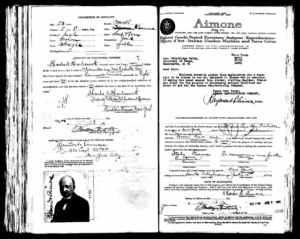
1920 Passport application for Raimondo Aimone’s annual furniture buying trip to Europe. |
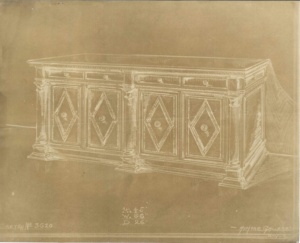
Sketch of custom made Credenza |
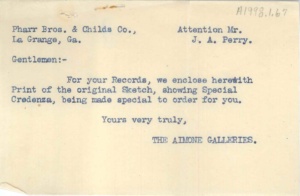
1915 letter from Aimone Galleries regarding the sketch of the custom made Credenza |
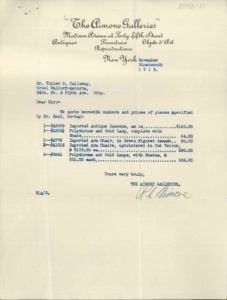
Furniture quote on Aimone Galleries letterhead in 1915. |
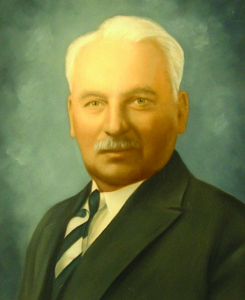
Gustave S. Jacobson |
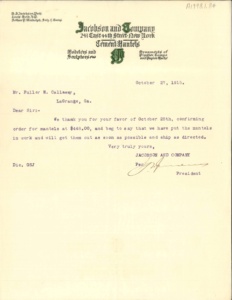
Original 1915 correspondence from Jacobson |
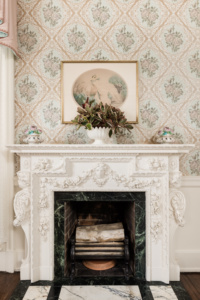
Jacobson mantel in home |
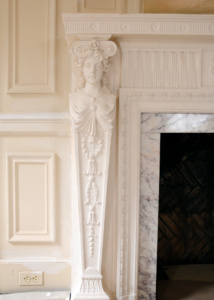
Jacobson mantel in home |
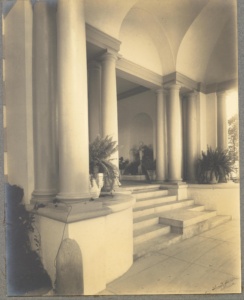
This 1916 image shows the limestone columns made by J. Hoadley & Sons. |
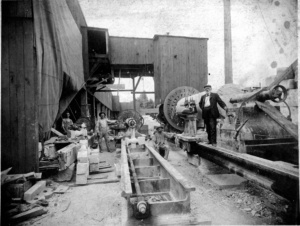
John Hoadley and workers stand next to the limestone lathe. |
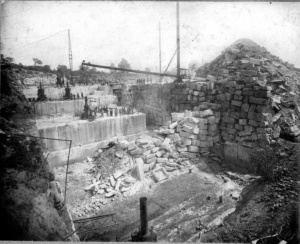
Workers harvest limestone from the Hoadley quarry in Stinesville, IN. Circa 1910 |
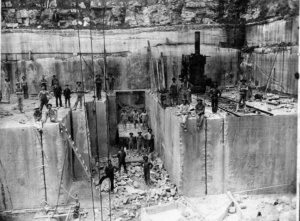
Workers harvest limestone from the Hoadley quarry in Stinesville, IN. Circa 1910 |
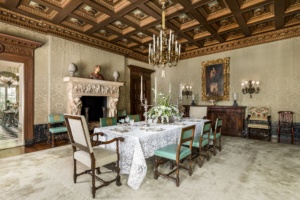
Dining room featuring the Koppe & Steinichen plaster ceiling with the two-tiered chandelier by Albert Moreau, ‘Madonna and Child’ painting from Cipriani Bros. Gallery, and Credenza from Aimone Galleries. |
View this entire Portico Newsletter:
